ICON College Unit 17: Understanding and Leading Change Report
VerifiedAdded on 2023/01/05
|17
|5378
|42
Report
AI Summary
This report delves into the multifaceted aspects of understanding and leading change within organizations, with a specific focus on the retail industry and a case study of Tesco. It begins by defining change management and its importance, exploring both internal and external drivers of organizational change, such as the need to improve capabilities, customer demands, emerging growth opportunities, and increasing competition. The report then examines the impact of these drivers on leadership and organizational behavior, considering factors like organizational culture, capabilities, objectives, and the influence of PESTEL analysis. It further discusses measures to reduce the negative impacts of change, including the application of change management models like Lewin's Freeze-Unfreeze model. The analysis extends to the driving and resisting forces involved in leading change, and concludes by examining various leadership approaches in change management, providing a comprehensive overview of the topic.
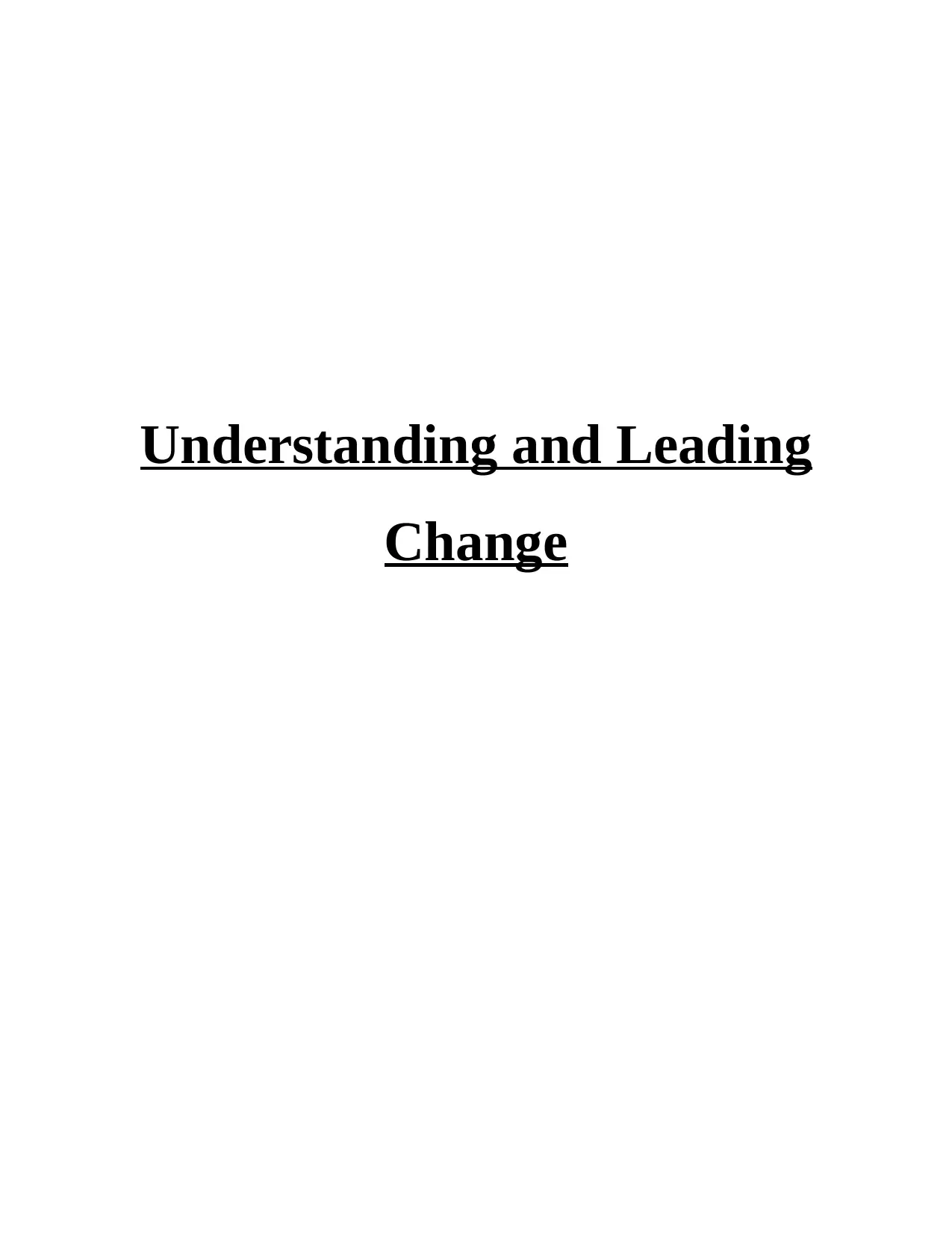
Understanding and Leading
Change
Change
Paraphrase This Document
Need a fresh take? Get an instant paraphrase of this document with our AI Paraphraser
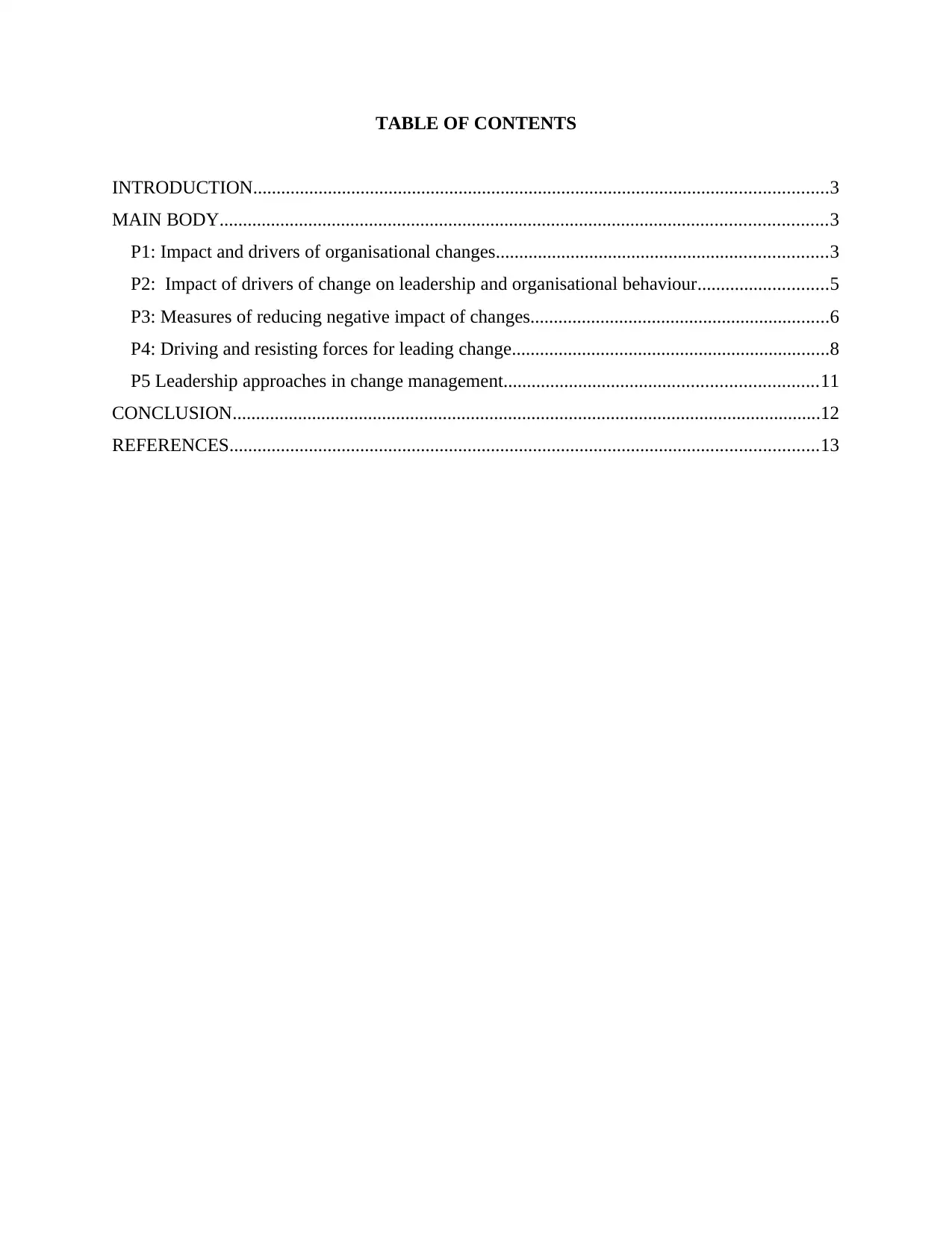
TABLE OF CONTENTS
INTRODUCTION...........................................................................................................................3
MAIN BODY..................................................................................................................................3
P1: Impact and drivers of organisational changes.......................................................................3
P2: Impact of drivers of change on leadership and organisational behaviour............................5
P3: Measures of reducing negative impact of changes................................................................6
P4: Driving and resisting forces for leading change....................................................................8
P5 Leadership approaches in change management...................................................................11
CONCLUSION..............................................................................................................................12
REFERENCES..............................................................................................................................13
INTRODUCTION...........................................................................................................................3
MAIN BODY..................................................................................................................................3
P1: Impact and drivers of organisational changes.......................................................................3
P2: Impact of drivers of change on leadership and organisational behaviour............................5
P3: Measures of reducing negative impact of changes................................................................6
P4: Driving and resisting forces for leading change....................................................................8
P5 Leadership approaches in change management...................................................................11
CONCLUSION..............................................................................................................................12
REFERENCES..............................................................................................................................13
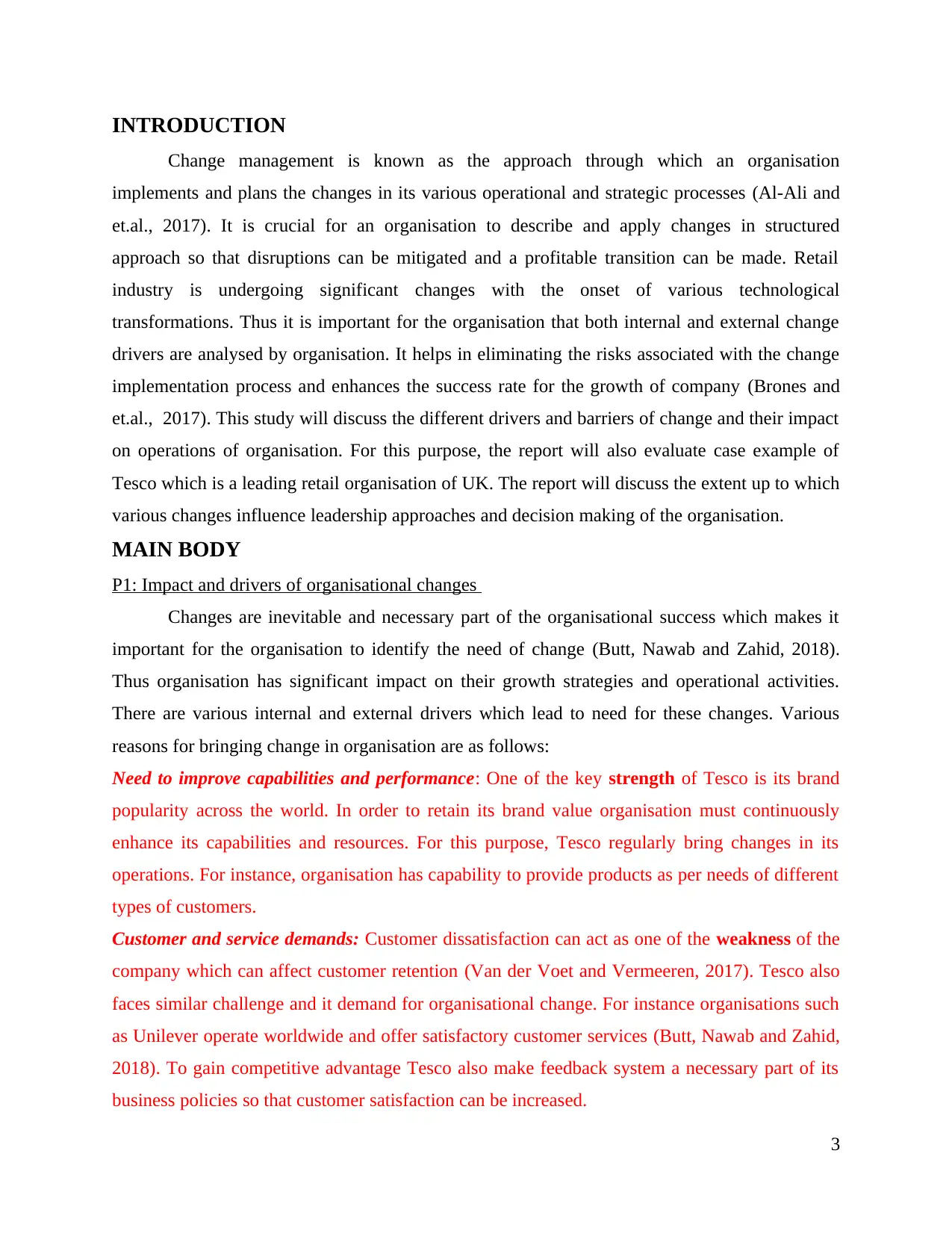
INTRODUCTION
Change management is known as the approach through which an organisation
implements and plans the changes in its various operational and strategic processes (Al-Ali and
et.al., 2017). It is crucial for an organisation to describe and apply changes in structured
approach so that disruptions can be mitigated and a profitable transition can be made. Retail
industry is undergoing significant changes with the onset of various technological
transformations. Thus it is important for the organisation that both internal and external change
drivers are analysed by organisation. It helps in eliminating the risks associated with the change
implementation process and enhances the success rate for the growth of company (Brones and
et.al., 2017). This study will discuss the different drivers and barriers of change and their impact
on operations of organisation. For this purpose, the report will also evaluate case example of
Tesco which is a leading retail organisation of UK. The report will discuss the extent up to which
various changes influence leadership approaches and decision making of the organisation.
MAIN BODY
P1: Impact and drivers of organisational changes
Changes are inevitable and necessary part of the organisational success which makes it
important for the organisation to identify the need of change (Butt, Nawab and Zahid, 2018).
Thus organisation has significant impact on their growth strategies and operational activities.
There are various internal and external drivers which lead to need for these changes. Various
reasons for bringing change in organisation are as follows:
Need to improve capabilities and performance: One of the key strength of Tesco is its brand
popularity across the world. In order to retain its brand value organisation must continuously
enhance its capabilities and resources. For this purpose, Tesco regularly bring changes in its
operations. For instance, organisation has capability to provide products as per needs of different
types of customers.
Customer and service demands: Customer dissatisfaction can act as one of the weakness of the
company which can affect customer retention (Van der Voet and Vermeeren, 2017). Tesco also
faces similar challenge and it demand for organisational change. For instance organisations such
as Unilever operate worldwide and offer satisfactory customer services (Butt, Nawab and Zahid,
2018). To gain competitive advantage Tesco also make feedback system a necessary part of its
business policies so that customer satisfaction can be increased.
3
Change management is known as the approach through which an organisation
implements and plans the changes in its various operational and strategic processes (Al-Ali and
et.al., 2017). It is crucial for an organisation to describe and apply changes in structured
approach so that disruptions can be mitigated and a profitable transition can be made. Retail
industry is undergoing significant changes with the onset of various technological
transformations. Thus it is important for the organisation that both internal and external change
drivers are analysed by organisation. It helps in eliminating the risks associated with the change
implementation process and enhances the success rate for the growth of company (Brones and
et.al., 2017). This study will discuss the different drivers and barriers of change and their impact
on operations of organisation. For this purpose, the report will also evaluate case example of
Tesco which is a leading retail organisation of UK. The report will discuss the extent up to which
various changes influence leadership approaches and decision making of the organisation.
MAIN BODY
P1: Impact and drivers of organisational changes
Changes are inevitable and necessary part of the organisational success which makes it
important for the organisation to identify the need of change (Butt, Nawab and Zahid, 2018).
Thus organisation has significant impact on their growth strategies and operational activities.
There are various internal and external drivers which lead to need for these changes. Various
reasons for bringing change in organisation are as follows:
Need to improve capabilities and performance: One of the key strength of Tesco is its brand
popularity across the world. In order to retain its brand value organisation must continuously
enhance its capabilities and resources. For this purpose, Tesco regularly bring changes in its
operations. For instance, organisation has capability to provide products as per needs of different
types of customers.
Customer and service demands: Customer dissatisfaction can act as one of the weakness of the
company which can affect customer retention (Van der Voet and Vermeeren, 2017). Tesco also
faces similar challenge and it demand for organisational change. For instance organisations such
as Unilever operate worldwide and offer satisfactory customer services (Butt, Nawab and Zahid,
2018). To gain competitive advantage Tesco also make feedback system a necessary part of its
business policies so that customer satisfaction can be increased.
3
⊘ This is a preview!⊘
Do you want full access?
Subscribe today to unlock all pages.

Trusted by 1+ million students worldwide
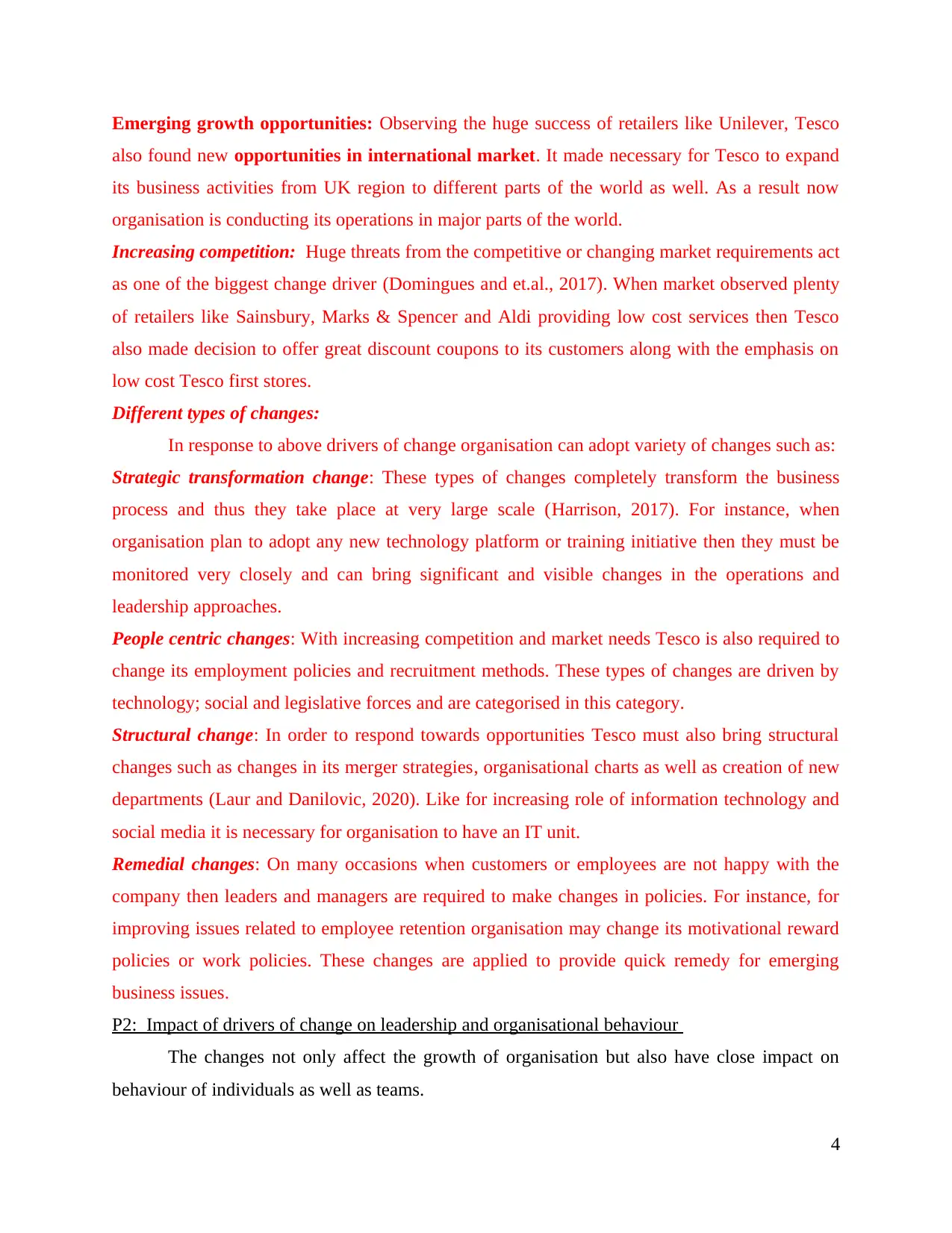
Emerging growth opportunities: Observing the huge success of retailers like Unilever, Tesco
also found new opportunities in international market. It made necessary for Tesco to expand
its business activities from UK region to different parts of the world as well. As a result now
organisation is conducting its operations in major parts of the world.
Increasing competition: Huge threats from the competitive or changing market requirements act
as one of the biggest change driver (Domingues and et.al., 2017). When market observed plenty
of retailers like Sainsbury, Marks & Spencer and Aldi providing low cost services then Tesco
also made decision to offer great discount coupons to its customers along with the emphasis on
low cost Tesco first stores.
Different types of changes:
In response to above drivers of change organisation can adopt variety of changes such as:
Strategic transformation change: These types of changes completely transform the business
process and thus they take place at very large scale (Harrison, 2017). For instance, when
organisation plan to adopt any new technology platform or training initiative then they must be
monitored very closely and can bring significant and visible changes in the operations and
leadership approaches.
People centric changes: With increasing competition and market needs Tesco is also required to
change its employment policies and recruitment methods. These types of changes are driven by
technology; social and legislative forces and are categorised in this category.
Structural change: In order to respond towards opportunities Tesco must also bring structural
changes such as changes in its merger strategies, organisational charts as well as creation of new
departments (Laur and Danilovic, 2020). Like for increasing role of information technology and
social media it is necessary for organisation to have an IT unit.
Remedial changes: On many occasions when customers or employees are not happy with the
company then leaders and managers are required to make changes in policies. For instance, for
improving issues related to employee retention organisation may change its motivational reward
policies or work policies. These changes are applied to provide quick remedy for emerging
business issues.
P2: Impact of drivers of change on leadership and organisational behaviour
The changes not only affect the growth of organisation but also have close impact on
behaviour of individuals as well as teams.
4
also found new opportunities in international market. It made necessary for Tesco to expand
its business activities from UK region to different parts of the world as well. As a result now
organisation is conducting its operations in major parts of the world.
Increasing competition: Huge threats from the competitive or changing market requirements act
as one of the biggest change driver (Domingues and et.al., 2017). When market observed plenty
of retailers like Sainsbury, Marks & Spencer and Aldi providing low cost services then Tesco
also made decision to offer great discount coupons to its customers along with the emphasis on
low cost Tesco first stores.
Different types of changes:
In response to above drivers of change organisation can adopt variety of changes such as:
Strategic transformation change: These types of changes completely transform the business
process and thus they take place at very large scale (Harrison, 2017). For instance, when
organisation plan to adopt any new technology platform or training initiative then they must be
monitored very closely and can bring significant and visible changes in the operations and
leadership approaches.
People centric changes: With increasing competition and market needs Tesco is also required to
change its employment policies and recruitment methods. These types of changes are driven by
technology; social and legislative forces and are categorised in this category.
Structural change: In order to respond towards opportunities Tesco must also bring structural
changes such as changes in its merger strategies, organisational charts as well as creation of new
departments (Laur and Danilovic, 2020). Like for increasing role of information technology and
social media it is necessary for organisation to have an IT unit.
Remedial changes: On many occasions when customers or employees are not happy with the
company then leaders and managers are required to make changes in policies. For instance, for
improving issues related to employee retention organisation may change its motivational reward
policies or work policies. These changes are applied to provide quick remedy for emerging
business issues.
P2: Impact of drivers of change on leadership and organisational behaviour
The changes not only affect the growth of organisation but also have close impact on
behaviour of individuals as well as teams.
4
Paraphrase This Document
Need a fresh take? Get an instant paraphrase of this document with our AI Paraphraser
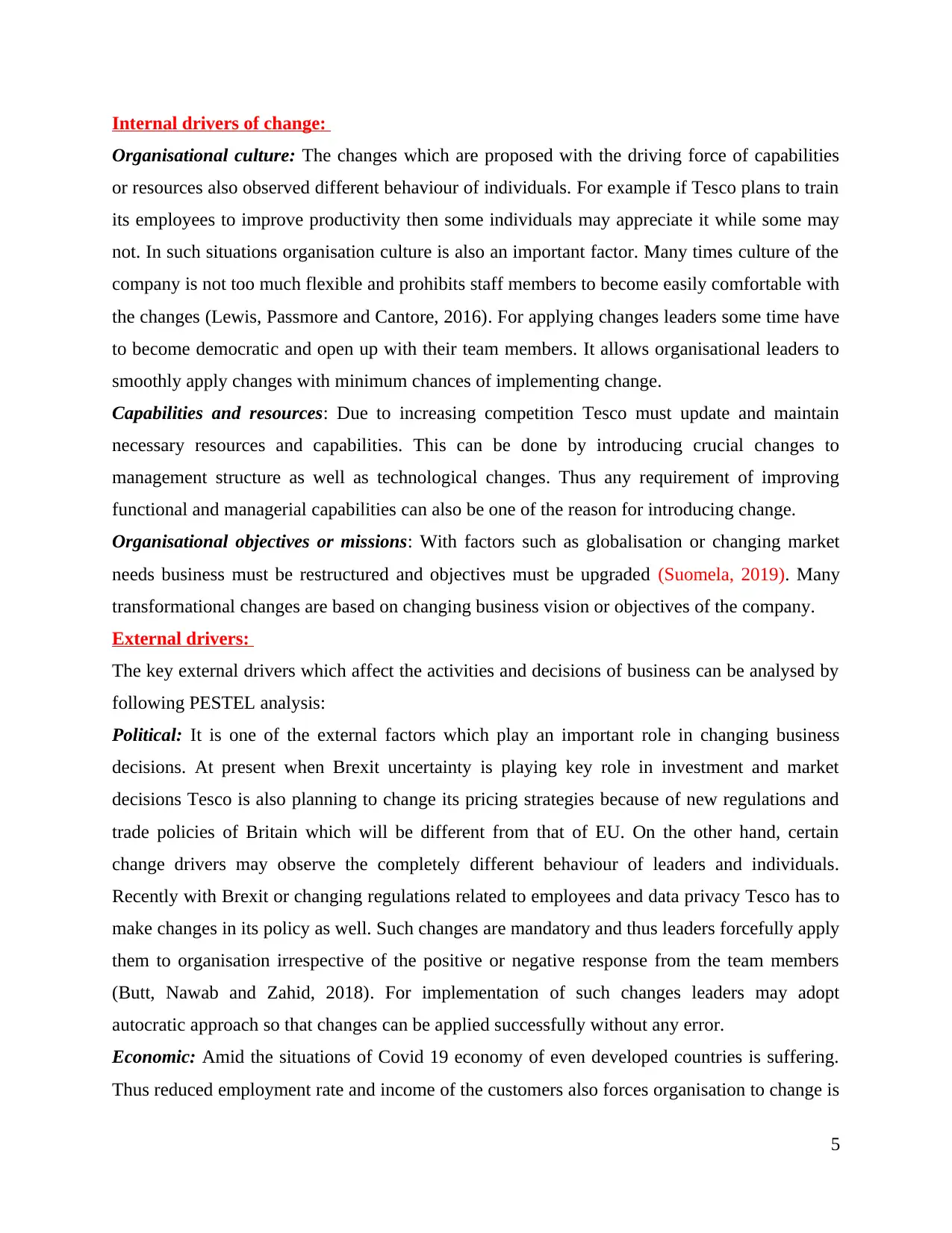
Internal drivers of change:
Organisational culture: The changes which are proposed with the driving force of capabilities
or resources also observed different behaviour of individuals. For example if Tesco plans to train
its employees to improve productivity then some individuals may appreciate it while some may
not. In such situations organisation culture is also an important factor. Many times culture of the
company is not too much flexible and prohibits staff members to become easily comfortable with
the changes (Lewis, Passmore and Cantore, 2016). For applying changes leaders some time have
to become democratic and open up with their team members. It allows organisational leaders to
smoothly apply changes with minimum chances of implementing change.
Capabilities and resources: Due to increasing competition Tesco must update and maintain
necessary resources and capabilities. This can be done by introducing crucial changes to
management structure as well as technological changes. Thus any requirement of improving
functional and managerial capabilities can also be one of the reason for introducing change.
Organisational objectives or missions: With factors such as globalisation or changing market
needs business must be restructured and objectives must be upgraded (Suomela, 2019). Many
transformational changes are based on changing business vision or objectives of the company.
External drivers:
The key external drivers which affect the activities and decisions of business can be analysed by
following PESTEL analysis:
Political: It is one of the external factors which play an important role in changing business
decisions. At present when Brexit uncertainty is playing key role in investment and market
decisions Tesco is also planning to change its pricing strategies because of new regulations and
trade policies of Britain which will be different from that of EU. On the other hand, certain
change drivers may observe the completely different behaviour of leaders and individuals.
Recently with Brexit or changing regulations related to employees and data privacy Tesco has to
make changes in its policy as well. Such changes are mandatory and thus leaders forcefully apply
them to organisation irrespective of the positive or negative response from the team members
(Butt, Nawab and Zahid, 2018). For implementation of such changes leaders may adopt
autocratic approach so that changes can be applied successfully without any error.
Economic: Amid the situations of Covid 19 economy of even developed countries is suffering.
Thus reduced employment rate and income of the customers also forces organisation to change is
5
Organisational culture: The changes which are proposed with the driving force of capabilities
or resources also observed different behaviour of individuals. For example if Tesco plans to train
its employees to improve productivity then some individuals may appreciate it while some may
not. In such situations organisation culture is also an important factor. Many times culture of the
company is not too much flexible and prohibits staff members to become easily comfortable with
the changes (Lewis, Passmore and Cantore, 2016). For applying changes leaders some time have
to become democratic and open up with their team members. It allows organisational leaders to
smoothly apply changes with minimum chances of implementing change.
Capabilities and resources: Due to increasing competition Tesco must update and maintain
necessary resources and capabilities. This can be done by introducing crucial changes to
management structure as well as technological changes. Thus any requirement of improving
functional and managerial capabilities can also be one of the reason for introducing change.
Organisational objectives or missions: With factors such as globalisation or changing market
needs business must be restructured and objectives must be upgraded (Suomela, 2019). Many
transformational changes are based on changing business vision or objectives of the company.
External drivers:
The key external drivers which affect the activities and decisions of business can be analysed by
following PESTEL analysis:
Political: It is one of the external factors which play an important role in changing business
decisions. At present when Brexit uncertainty is playing key role in investment and market
decisions Tesco is also planning to change its pricing strategies because of new regulations and
trade policies of Britain which will be different from that of EU. On the other hand, certain
change drivers may observe the completely different behaviour of leaders and individuals.
Recently with Brexit or changing regulations related to employees and data privacy Tesco has to
make changes in its policy as well. Such changes are mandatory and thus leaders forcefully apply
them to organisation irrespective of the positive or negative response from the team members
(Butt, Nawab and Zahid, 2018). For implementation of such changes leaders may adopt
autocratic approach so that changes can be applied successfully without any error.
Economic: Amid the situations of Covid 19 economy of even developed countries is suffering.
Thus reduced employment rate and income of the customers also forces organisation to change is
5
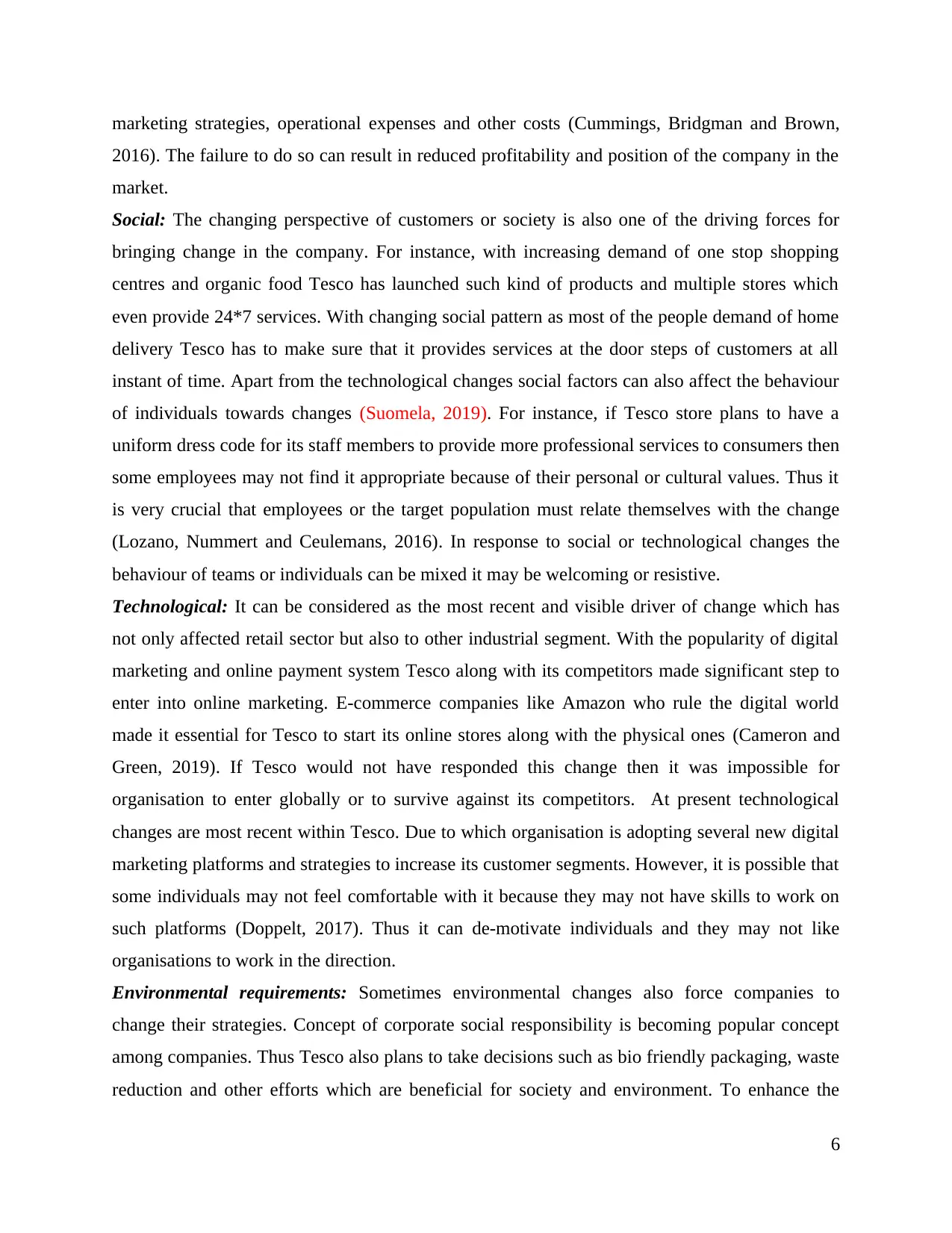
marketing strategies, operational expenses and other costs (Cummings, Bridgman and Brown,
2016). The failure to do so can result in reduced profitability and position of the company in the
market.
Social: The changing perspective of customers or society is also one of the driving forces for
bringing change in the company. For instance, with increasing demand of one stop shopping
centres and organic food Tesco has launched such kind of products and multiple stores which
even provide 24*7 services. With changing social pattern as most of the people demand of home
delivery Tesco has to make sure that it provides services at the door steps of customers at all
instant of time. Apart from the technological changes social factors can also affect the behaviour
of individuals towards changes (Suomela, 2019). For instance, if Tesco store plans to have a
uniform dress code for its staff members to provide more professional services to consumers then
some employees may not find it appropriate because of their personal or cultural values. Thus it
is very crucial that employees or the target population must relate themselves with the change
(Lozano, Nummert and Ceulemans, 2016). In response to social or technological changes the
behaviour of teams or individuals can be mixed it may be welcoming or resistive.
Technological: It can be considered as the most recent and visible driver of change which has
not only affected retail sector but also to other industrial segment. With the popularity of digital
marketing and online payment system Tesco along with its competitors made significant step to
enter into online marketing. E-commerce companies like Amazon who rule the digital world
made it essential for Tesco to start its online stores along with the physical ones (Cameron and
Green, 2019). If Tesco would not have responded this change then it was impossible for
organisation to enter globally or to survive against its competitors. At present technological
changes are most recent within Tesco. Due to which organisation is adopting several new digital
marketing platforms and strategies to increase its customer segments. However, it is possible that
some individuals may not feel comfortable with it because they may not have skills to work on
such platforms (Doppelt, 2017). Thus it can de-motivate individuals and they may not like
organisations to work in the direction.
Environmental requirements: Sometimes environmental changes also force companies to
change their strategies. Concept of corporate social responsibility is becoming popular concept
among companies. Thus Tesco also plans to take decisions such as bio friendly packaging, waste
reduction and other efforts which are beneficial for society and environment. To enhance the
6
2016). The failure to do so can result in reduced profitability and position of the company in the
market.
Social: The changing perspective of customers or society is also one of the driving forces for
bringing change in the company. For instance, with increasing demand of one stop shopping
centres and organic food Tesco has launched such kind of products and multiple stores which
even provide 24*7 services. With changing social pattern as most of the people demand of home
delivery Tesco has to make sure that it provides services at the door steps of customers at all
instant of time. Apart from the technological changes social factors can also affect the behaviour
of individuals towards changes (Suomela, 2019). For instance, if Tesco store plans to have a
uniform dress code for its staff members to provide more professional services to consumers then
some employees may not find it appropriate because of their personal or cultural values. Thus it
is very crucial that employees or the target population must relate themselves with the change
(Lozano, Nummert and Ceulemans, 2016). In response to social or technological changes the
behaviour of teams or individuals can be mixed it may be welcoming or resistive.
Technological: It can be considered as the most recent and visible driver of change which has
not only affected retail sector but also to other industrial segment. With the popularity of digital
marketing and online payment system Tesco along with its competitors made significant step to
enter into online marketing. E-commerce companies like Amazon who rule the digital world
made it essential for Tesco to start its online stores along with the physical ones (Cameron and
Green, 2019). If Tesco would not have responded this change then it was impossible for
organisation to enter globally or to survive against its competitors. At present technological
changes are most recent within Tesco. Due to which organisation is adopting several new digital
marketing platforms and strategies to increase its customer segments. However, it is possible that
some individuals may not feel comfortable with it because they may not have skills to work on
such platforms (Doppelt, 2017). Thus it can de-motivate individuals and they may not like
organisations to work in the direction.
Environmental requirements: Sometimes environmental changes also force companies to
change their strategies. Concept of corporate social responsibility is becoming popular concept
among companies. Thus Tesco also plans to take decisions such as bio friendly packaging, waste
reduction and other efforts which are beneficial for society and environment. To enhance the
6
⊘ This is a preview!⊘
Do you want full access?
Subscribe today to unlock all pages.

Trusted by 1+ million students worldwide
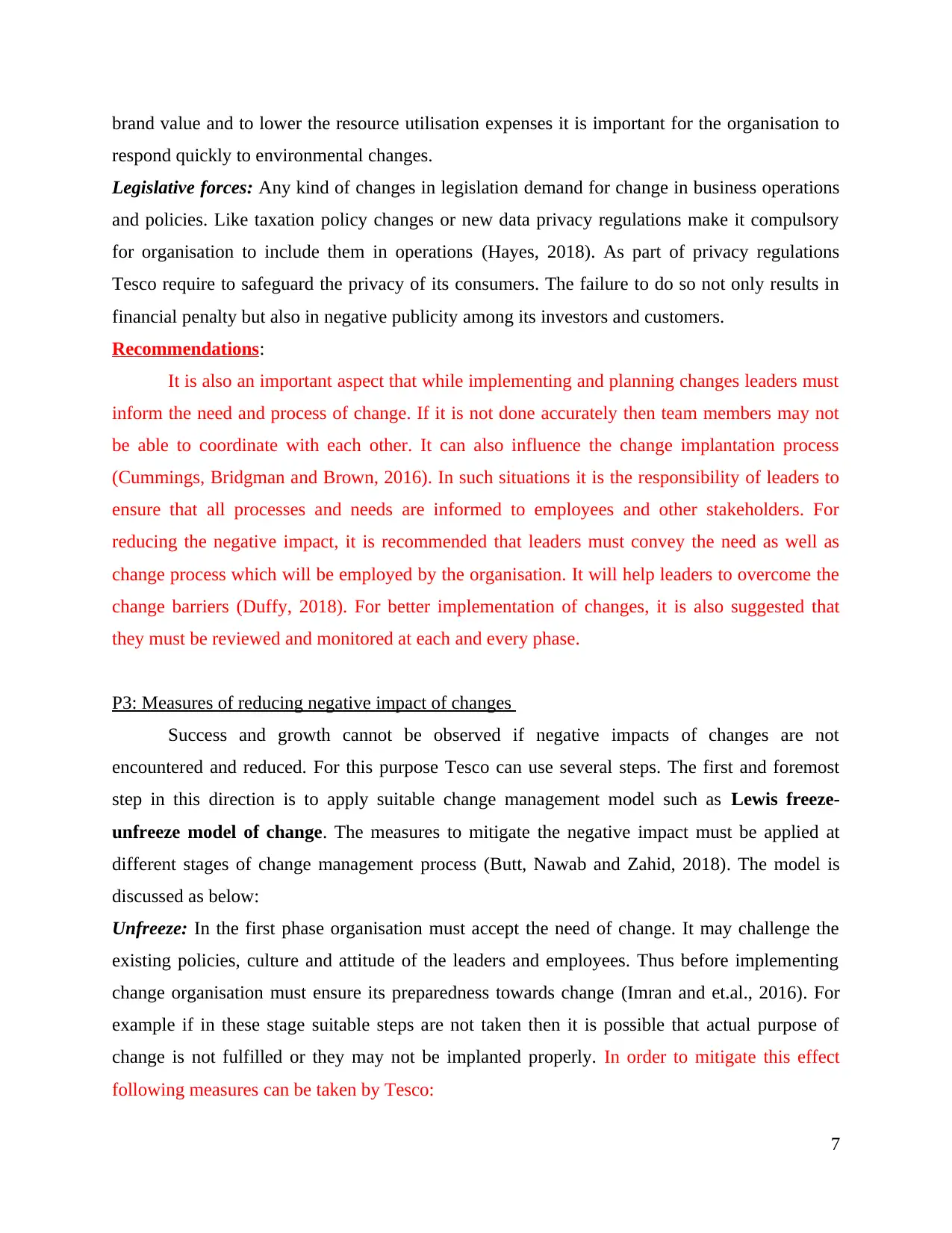
brand value and to lower the resource utilisation expenses it is important for the organisation to
respond quickly to environmental changes.
Legislative forces: Any kind of changes in legislation demand for change in business operations
and policies. Like taxation policy changes or new data privacy regulations make it compulsory
for organisation to include them in operations (Hayes, 2018). As part of privacy regulations
Tesco require to safeguard the privacy of its consumers. The failure to do so not only results in
financial penalty but also in negative publicity among its investors and customers.
Recommendations:
It is also an important aspect that while implementing and planning changes leaders must
inform the need and process of change. If it is not done accurately then team members may not
be able to coordinate with each other. It can also influence the change implantation process
(Cummings, Bridgman and Brown, 2016). In such situations it is the responsibility of leaders to
ensure that all processes and needs are informed to employees and other stakeholders. For
reducing the negative impact, it is recommended that leaders must convey the need as well as
change process which will be employed by the organisation. It will help leaders to overcome the
change barriers (Duffy, 2018). For better implementation of changes, it is also suggested that
they must be reviewed and monitored at each and every phase.
P3: Measures of reducing negative impact of changes
Success and growth cannot be observed if negative impacts of changes are not
encountered and reduced. For this purpose Tesco can use several steps. The first and foremost
step in this direction is to apply suitable change management model such as Lewis freeze-
unfreeze model of change. The measures to mitigate the negative impact must be applied at
different stages of change management process (Butt, Nawab and Zahid, 2018). The model is
discussed as below:
Unfreeze: In the first phase organisation must accept the need of change. It may challenge the
existing policies, culture and attitude of the leaders and employees. Thus before implementing
change organisation must ensure its preparedness towards change (Imran and et.al., 2016). For
example if in these stage suitable steps are not taken then it is possible that actual purpose of
change is not fulfilled or they may not be implanted properly. In order to mitigate this effect
following measures can be taken by Tesco:
7
respond quickly to environmental changes.
Legislative forces: Any kind of changes in legislation demand for change in business operations
and policies. Like taxation policy changes or new data privacy regulations make it compulsory
for organisation to include them in operations (Hayes, 2018). As part of privacy regulations
Tesco require to safeguard the privacy of its consumers. The failure to do so not only results in
financial penalty but also in negative publicity among its investors and customers.
Recommendations:
It is also an important aspect that while implementing and planning changes leaders must
inform the need and process of change. If it is not done accurately then team members may not
be able to coordinate with each other. It can also influence the change implantation process
(Cummings, Bridgman and Brown, 2016). In such situations it is the responsibility of leaders to
ensure that all processes and needs are informed to employees and other stakeholders. For
reducing the negative impact, it is recommended that leaders must convey the need as well as
change process which will be employed by the organisation. It will help leaders to overcome the
change barriers (Duffy, 2018). For better implementation of changes, it is also suggested that
they must be reviewed and monitored at each and every phase.
P3: Measures of reducing negative impact of changes
Success and growth cannot be observed if negative impacts of changes are not
encountered and reduced. For this purpose Tesco can use several steps. The first and foremost
step in this direction is to apply suitable change management model such as Lewis freeze-
unfreeze model of change. The measures to mitigate the negative impact must be applied at
different stages of change management process (Butt, Nawab and Zahid, 2018). The model is
discussed as below:
Unfreeze: In the first phase organisation must accept the need of change. It may challenge the
existing policies, culture and attitude of the leaders and employees. Thus before implementing
change organisation must ensure its preparedness towards change (Imran and et.al., 2016). For
example if in these stage suitable steps are not taken then it is possible that actual purpose of
change is not fulfilled or they may not be implanted properly. In order to mitigate this effect
following measures can be taken by Tesco:
7
Paraphrase This Document
Need a fresh take? Get an instant paraphrase of this document with our AI Paraphraser
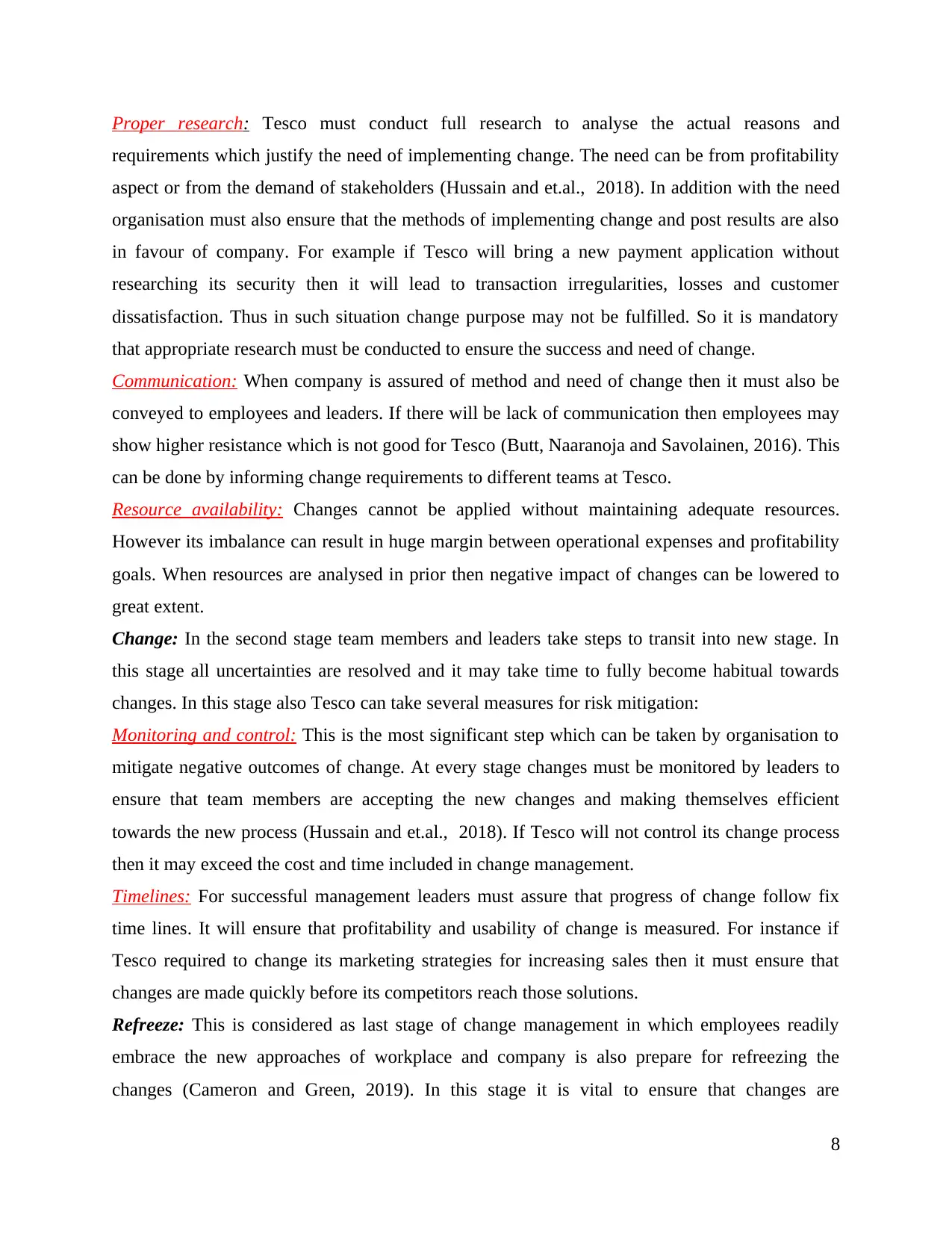
Proper research: Tesco must conduct full research to analyse the actual reasons and
requirements which justify the need of implementing change. The need can be from profitability
aspect or from the demand of stakeholders (Hussain and et.al., 2018). In addition with the need
organisation must also ensure that the methods of implementing change and post results are also
in favour of company. For example if Tesco will bring a new payment application without
researching its security then it will lead to transaction irregularities, losses and customer
dissatisfaction. Thus in such situation change purpose may not be fulfilled. So it is mandatory
that appropriate research must be conducted to ensure the success and need of change.
Communication: When company is assured of method and need of change then it must also be
conveyed to employees and leaders. If there will be lack of communication then employees may
show higher resistance which is not good for Tesco (Butt, Naaranoja and Savolainen, 2016). This
can be done by informing change requirements to different teams at Tesco.
Resource availability: Changes cannot be applied without maintaining adequate resources.
However its imbalance can result in huge margin between operational expenses and profitability
goals. When resources are analysed in prior then negative impact of changes can be lowered to
great extent.
Change: In the second stage team members and leaders take steps to transit into new stage. In
this stage all uncertainties are resolved and it may take time to fully become habitual towards
changes. In this stage also Tesco can take several measures for risk mitigation:
Monitoring and control: This is the most significant step which can be taken by organisation to
mitigate negative outcomes of change. At every stage changes must be monitored by leaders to
ensure that team members are accepting the new changes and making themselves efficient
towards the new process (Hussain and et.al., 2018). If Tesco will not control its change process
then it may exceed the cost and time included in change management.
Timelines: For successful management leaders must assure that progress of change follow fix
time lines. It will ensure that profitability and usability of change is measured. For instance if
Tesco required to change its marketing strategies for increasing sales then it must ensure that
changes are made quickly before its competitors reach those solutions.
Refreeze: This is considered as last stage of change management in which employees readily
embrace the new approaches of workplace and company is also prepare for refreezing the
changes (Cameron and Green, 2019). In this stage it is vital to ensure that changes are
8
requirements which justify the need of implementing change. The need can be from profitability
aspect or from the demand of stakeholders (Hussain and et.al., 2018). In addition with the need
organisation must also ensure that the methods of implementing change and post results are also
in favour of company. For example if Tesco will bring a new payment application without
researching its security then it will lead to transaction irregularities, losses and customer
dissatisfaction. Thus in such situation change purpose may not be fulfilled. So it is mandatory
that appropriate research must be conducted to ensure the success and need of change.
Communication: When company is assured of method and need of change then it must also be
conveyed to employees and leaders. If there will be lack of communication then employees may
show higher resistance which is not good for Tesco (Butt, Naaranoja and Savolainen, 2016). This
can be done by informing change requirements to different teams at Tesco.
Resource availability: Changes cannot be applied without maintaining adequate resources.
However its imbalance can result in huge margin between operational expenses and profitability
goals. When resources are analysed in prior then negative impact of changes can be lowered to
great extent.
Change: In the second stage team members and leaders take steps to transit into new stage. In
this stage all uncertainties are resolved and it may take time to fully become habitual towards
changes. In this stage also Tesco can take several measures for risk mitigation:
Monitoring and control: This is the most significant step which can be taken by organisation to
mitigate negative outcomes of change. At every stage changes must be monitored by leaders to
ensure that team members are accepting the new changes and making themselves efficient
towards the new process (Hussain and et.al., 2018). If Tesco will not control its change process
then it may exceed the cost and time included in change management.
Timelines: For successful management leaders must assure that progress of change follow fix
time lines. It will ensure that profitability and usability of change is measured. For instance if
Tesco required to change its marketing strategies for increasing sales then it must ensure that
changes are made quickly before its competitors reach those solutions.
Refreeze: This is considered as last stage of change management in which employees readily
embrace the new approaches of workplace and company is also prepare for refreezing the
changes (Cameron and Green, 2019). In this stage it is vital to ensure that changes are
8
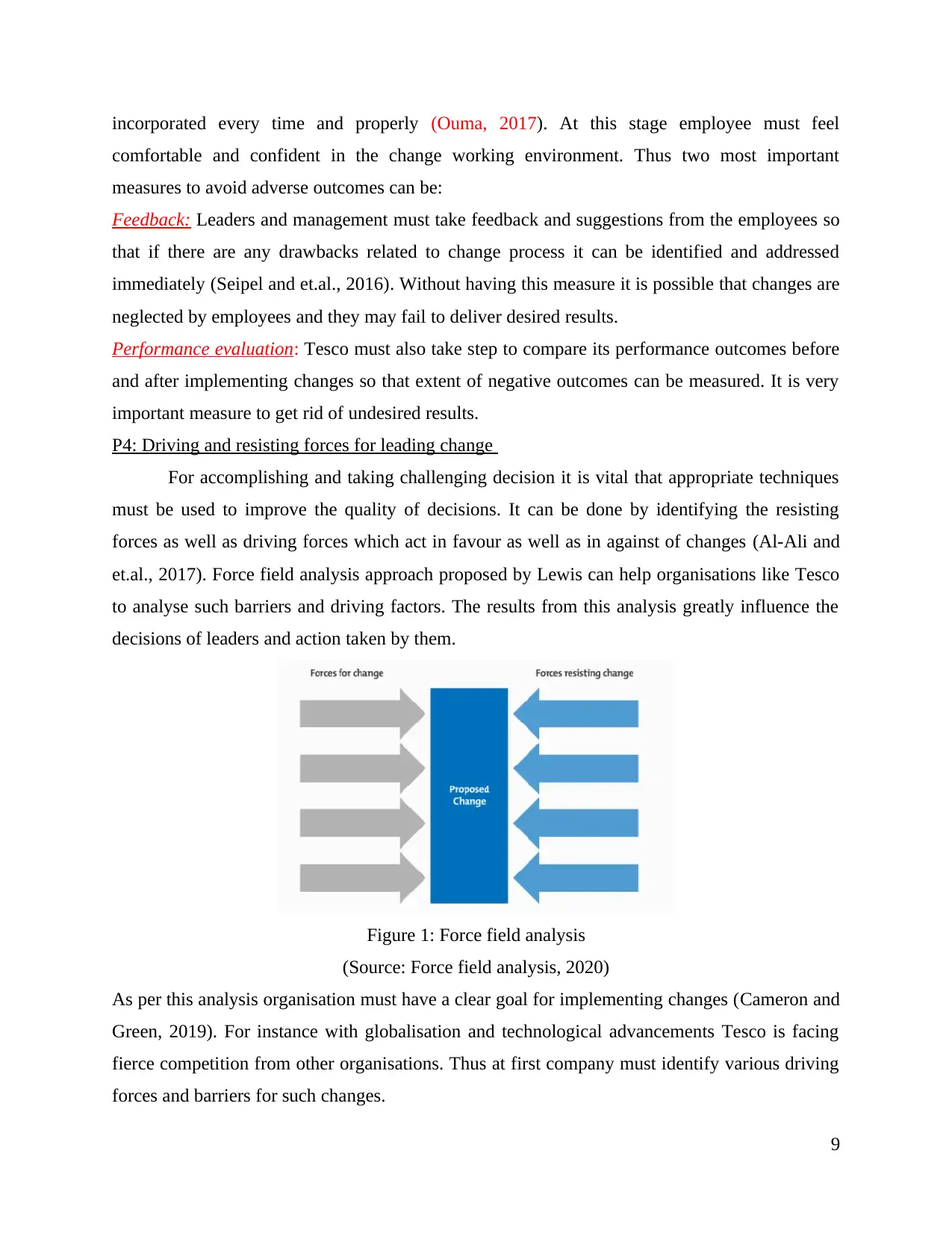
incorporated every time and properly (Ouma, 2017). At this stage employee must feel
comfortable and confident in the change working environment. Thus two most important
measures to avoid adverse outcomes can be:
Feedback: Leaders and management must take feedback and suggestions from the employees so
that if there are any drawbacks related to change process it can be identified and addressed
immediately (Seipel and et.al., 2016). Without having this measure it is possible that changes are
neglected by employees and they may fail to deliver desired results.
Performance evaluation: Tesco must also take step to compare its performance outcomes before
and after implementing changes so that extent of negative outcomes can be measured. It is very
important measure to get rid of undesired results.
P4: Driving and resisting forces for leading change
For accomplishing and taking challenging decision it is vital that appropriate techniques
must be used to improve the quality of decisions. It can be done by identifying the resisting
forces as well as driving forces which act in favour as well as in against of changes (Al-Ali and
et.al., 2017). Force field analysis approach proposed by Lewis can help organisations like Tesco
to analyse such barriers and driving factors. The results from this analysis greatly influence the
decisions of leaders and action taken by them.
Figure 1: Force field analysis
(Source: Force field analysis, 2020)
As per this analysis organisation must have a clear goal for implementing changes (Cameron and
Green, 2019). For instance with globalisation and technological advancements Tesco is facing
fierce competition from other organisations. Thus at first company must identify various driving
forces and barriers for such changes.
9
comfortable and confident in the change working environment. Thus two most important
measures to avoid adverse outcomes can be:
Feedback: Leaders and management must take feedback and suggestions from the employees so
that if there are any drawbacks related to change process it can be identified and addressed
immediately (Seipel and et.al., 2016). Without having this measure it is possible that changes are
neglected by employees and they may fail to deliver desired results.
Performance evaluation: Tesco must also take step to compare its performance outcomes before
and after implementing changes so that extent of negative outcomes can be measured. It is very
important measure to get rid of undesired results.
P4: Driving and resisting forces for leading change
For accomplishing and taking challenging decision it is vital that appropriate techniques
must be used to improve the quality of decisions. It can be done by identifying the resisting
forces as well as driving forces which act in favour as well as in against of changes (Al-Ali and
et.al., 2017). Force field analysis approach proposed by Lewis can help organisations like Tesco
to analyse such barriers and driving factors. The results from this analysis greatly influence the
decisions of leaders and action taken by them.
Figure 1: Force field analysis
(Source: Force field analysis, 2020)
As per this analysis organisation must have a clear goal for implementing changes (Cameron and
Green, 2019). For instance with globalisation and technological advancements Tesco is facing
fierce competition from other organisations. Thus at first company must identify various driving
forces and barriers for such changes.
9
⊘ This is a preview!⊘
Do you want full access?
Subscribe today to unlock all pages.

Trusted by 1+ million students worldwide
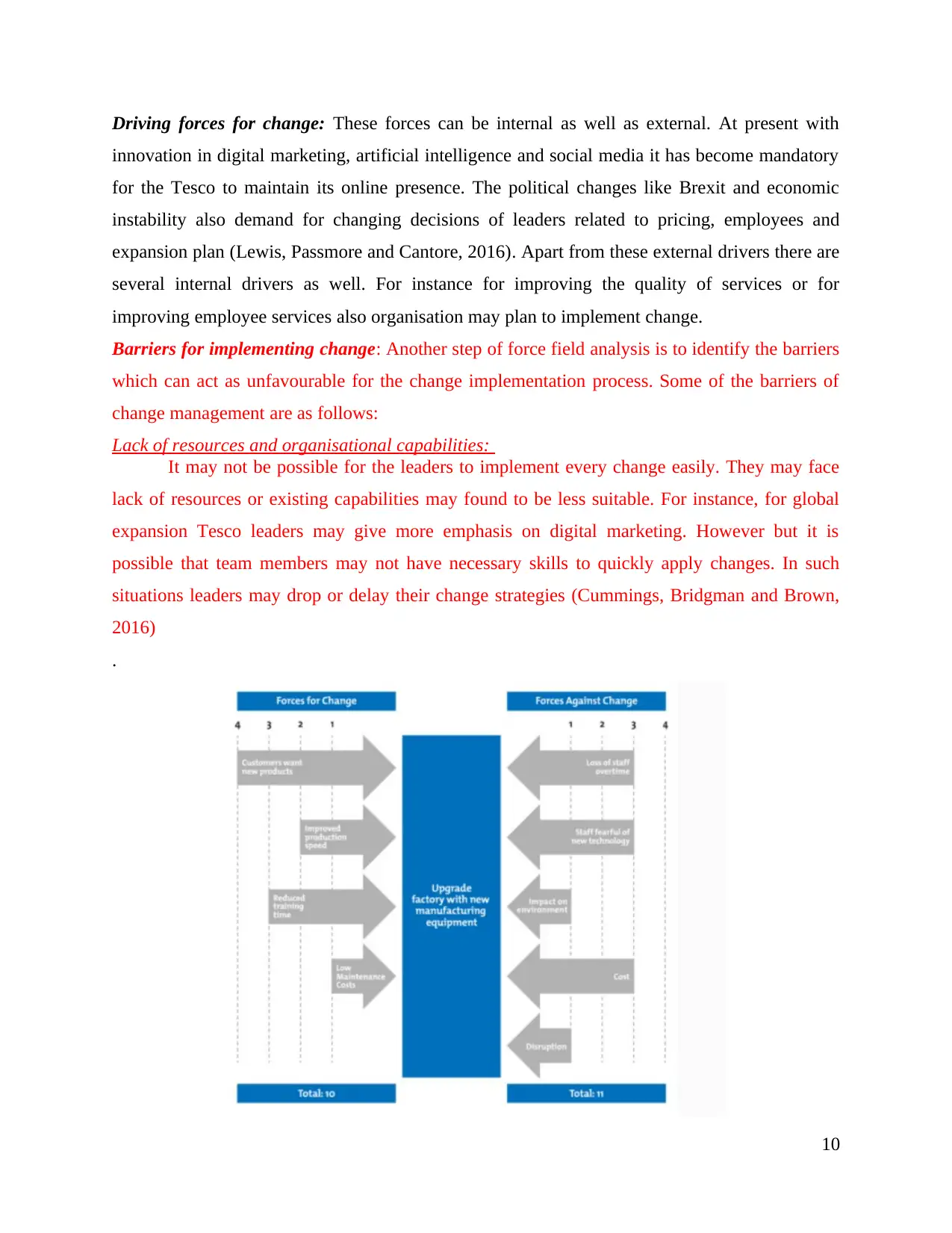
Driving forces for change: These forces can be internal as well as external. At present with
innovation in digital marketing, artificial intelligence and social media it has become mandatory
for the Tesco to maintain its online presence. The political changes like Brexit and economic
instability also demand for changing decisions of leaders related to pricing, employees and
expansion plan (Lewis, Passmore and Cantore, 2016). Apart from these external drivers there are
several internal drivers as well. For instance for improving the quality of services or for
improving employee services also organisation may plan to implement change.
Barriers for implementing change: Another step of force field analysis is to identify the barriers
which can act as unfavourable for the change implementation process. Some of the barriers of
change management are as follows:
Lack of resources and organisational capabilities:
It may not be possible for the leaders to implement every change easily. They may face
lack of resources or existing capabilities may found to be less suitable. For instance, for global
expansion Tesco leaders may give more emphasis on digital marketing. However but it is
possible that team members may not have necessary skills to quickly apply changes. In such
situations leaders may drop or delay their change strategies (Cummings, Bridgman and Brown,
2016)
.
10
innovation in digital marketing, artificial intelligence and social media it has become mandatory
for the Tesco to maintain its online presence. The political changes like Brexit and economic
instability also demand for changing decisions of leaders related to pricing, employees and
expansion plan (Lewis, Passmore and Cantore, 2016). Apart from these external drivers there are
several internal drivers as well. For instance for improving the quality of services or for
improving employee services also organisation may plan to implement change.
Barriers for implementing change: Another step of force field analysis is to identify the barriers
which can act as unfavourable for the change implementation process. Some of the barriers of
change management are as follows:
Lack of resources and organisational capabilities:
It may not be possible for the leaders to implement every change easily. They may face
lack of resources or existing capabilities may found to be less suitable. For instance, for global
expansion Tesco leaders may give more emphasis on digital marketing. However but it is
possible that team members may not have necessary skills to quickly apply changes. In such
situations leaders may drop or delay their change strategies (Cummings, Bridgman and Brown,
2016)
.
10
Paraphrase This Document
Need a fresh take? Get an instant paraphrase of this document with our AI Paraphraser
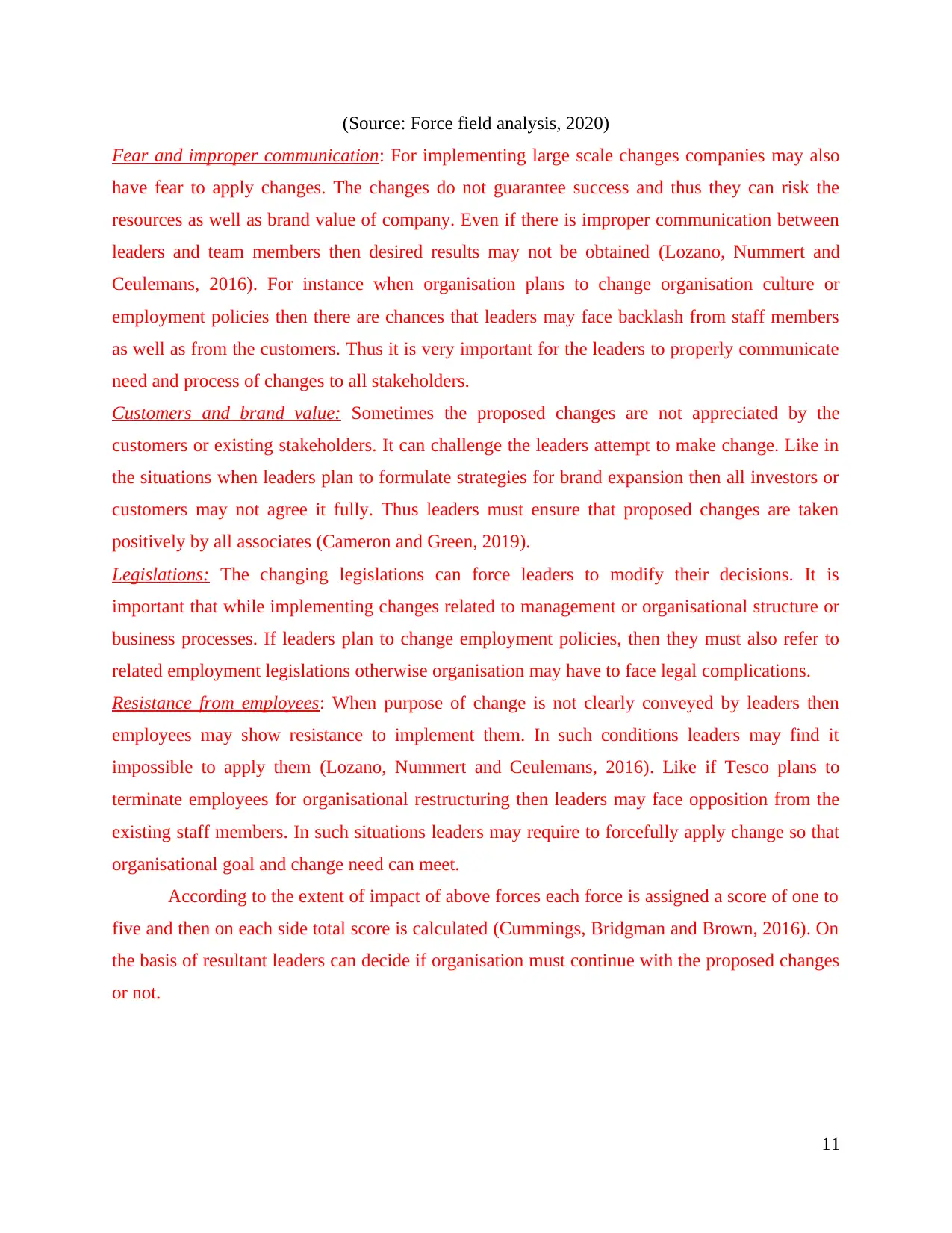
(Source: Force field analysis, 2020)
Fear and improper communication: For implementing large scale changes companies may also
have fear to apply changes. The changes do not guarantee success and thus they can risk the
resources as well as brand value of company. Even if there is improper communication between
leaders and team members then desired results may not be obtained (Lozano, Nummert and
Ceulemans, 2016). For instance when organisation plans to change organisation culture or
employment policies then there are chances that leaders may face backlash from staff members
as well as from the customers. Thus it is very important for the leaders to properly communicate
need and process of changes to all stakeholders.
Customers and brand value: Sometimes the proposed changes are not appreciated by the
customers or existing stakeholders. It can challenge the leaders attempt to make change. Like in
the situations when leaders plan to formulate strategies for brand expansion then all investors or
customers may not agree it fully. Thus leaders must ensure that proposed changes are taken
positively by all associates (Cameron and Green, 2019).
Legislations: The changing legislations can force leaders to modify their decisions. It is
important that while implementing changes related to management or organisational structure or
business processes. If leaders plan to change employment policies, then they must also refer to
related employment legislations otherwise organisation may have to face legal complications.
Resistance from employees: When purpose of change is not clearly conveyed by leaders then
employees may show resistance to implement them. In such conditions leaders may find it
impossible to apply them (Lozano, Nummert and Ceulemans, 2016). Like if Tesco plans to
terminate employees for organisational restructuring then leaders may face opposition from the
existing staff members. In such situations leaders may require to forcefully apply change so that
organisational goal and change need can meet.
According to the extent of impact of above forces each force is assigned a score of one to
five and then on each side total score is calculated (Cummings, Bridgman and Brown, 2016). On
the basis of resultant leaders can decide if organisation must continue with the proposed changes
or not.
11
Fear and improper communication: For implementing large scale changes companies may also
have fear to apply changes. The changes do not guarantee success and thus they can risk the
resources as well as brand value of company. Even if there is improper communication between
leaders and team members then desired results may not be obtained (Lozano, Nummert and
Ceulemans, 2016). For instance when organisation plans to change organisation culture or
employment policies then there are chances that leaders may face backlash from staff members
as well as from the customers. Thus it is very important for the leaders to properly communicate
need and process of changes to all stakeholders.
Customers and brand value: Sometimes the proposed changes are not appreciated by the
customers or existing stakeholders. It can challenge the leaders attempt to make change. Like in
the situations when leaders plan to formulate strategies for brand expansion then all investors or
customers may not agree it fully. Thus leaders must ensure that proposed changes are taken
positively by all associates (Cameron and Green, 2019).
Legislations: The changing legislations can force leaders to modify their decisions. It is
important that while implementing changes related to management or organisational structure or
business processes. If leaders plan to change employment policies, then they must also refer to
related employment legislations otherwise organisation may have to face legal complications.
Resistance from employees: When purpose of change is not clearly conveyed by leaders then
employees may show resistance to implement them. In such conditions leaders may find it
impossible to apply them (Lozano, Nummert and Ceulemans, 2016). Like if Tesco plans to
terminate employees for organisational restructuring then leaders may face opposition from the
existing staff members. In such situations leaders may require to forcefully apply change so that
organisational goal and change need can meet.
According to the extent of impact of above forces each force is assigned a score of one to
five and then on each side total score is calculated (Cummings, Bridgman and Brown, 2016). On
the basis of resultant leaders can decide if organisation must continue with the proposed changes
or not.
11
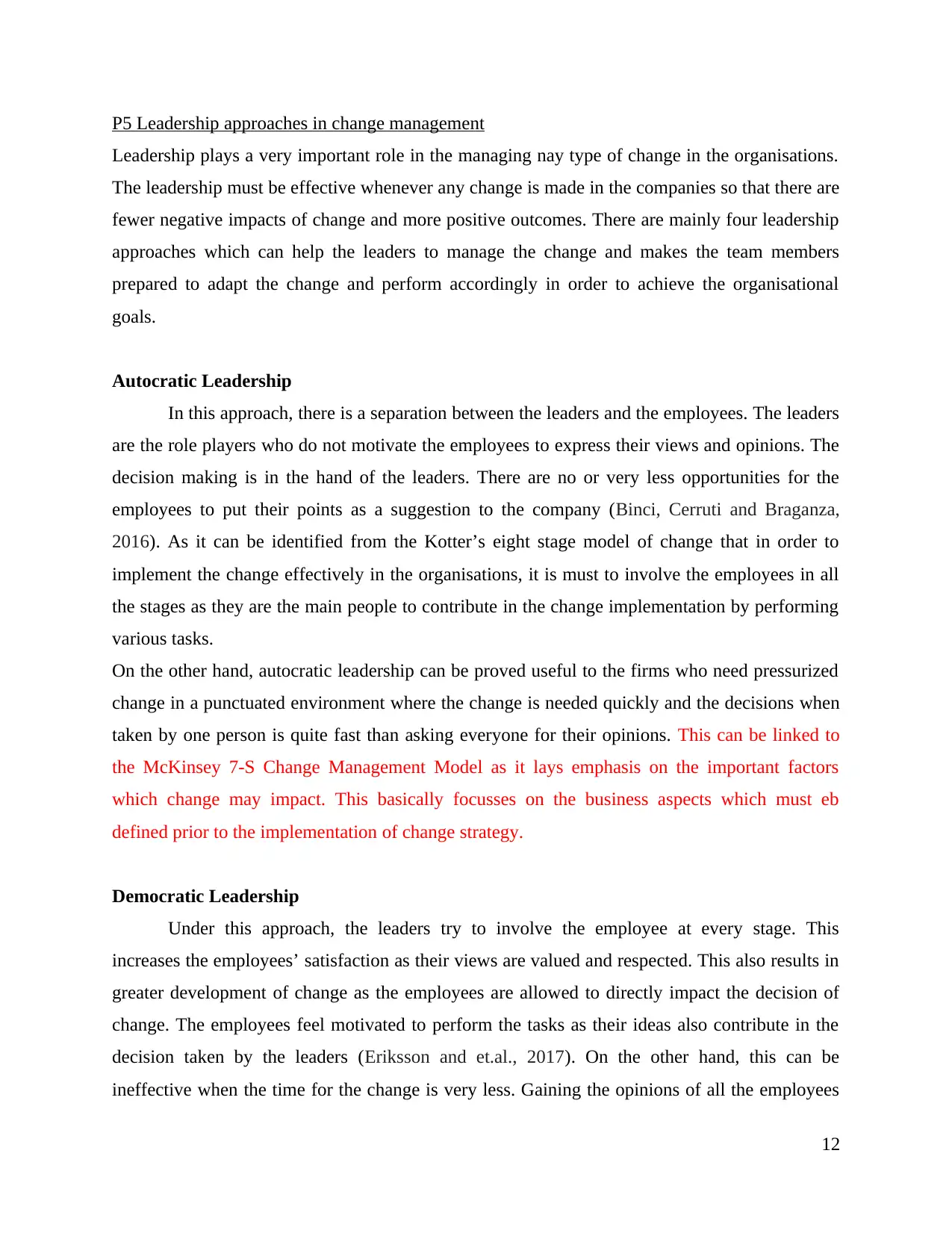
P5 Leadership approaches in change management
Leadership plays a very important role in the managing nay type of change in the organisations.
The leadership must be effective whenever any change is made in the companies so that there are
fewer negative impacts of change and more positive outcomes. There are mainly four leadership
approaches which can help the leaders to manage the change and makes the team members
prepared to adapt the change and perform accordingly in order to achieve the organisational
goals.
Autocratic Leadership
In this approach, there is a separation between the leaders and the employees. The leaders
are the role players who do not motivate the employees to express their views and opinions. The
decision making is in the hand of the leaders. There are no or very less opportunities for the
employees to put their points as a suggestion to the company (Binci, Cerruti and Braganza,
2016). As it can be identified from the Kotter’s eight stage model of change that in order to
implement the change effectively in the organisations, it is must to involve the employees in all
the stages as they are the main people to contribute in the change implementation by performing
various tasks.
On the other hand, autocratic leadership can be proved useful to the firms who need pressurized
change in a punctuated environment where the change is needed quickly and the decisions when
taken by one person is quite fast than asking everyone for their opinions. This can be linked to
the McKinsey 7-S Change Management Model as it lays emphasis on the important factors
which change may impact. This basically focusses on the business aspects which must eb
defined prior to the implementation of change strategy.
Democratic Leadership
Under this approach, the leaders try to involve the employee at every stage. This
increases the employees’ satisfaction as their views are valued and respected. This also results in
greater development of change as the employees are allowed to directly impact the decision of
change. The employees feel motivated to perform the tasks as their ideas also contribute in the
decision taken by the leaders (Eriksson and et.al., 2017). On the other hand, this can be
ineffective when the time for the change is very less. Gaining the opinions of all the employees
12
Leadership plays a very important role in the managing nay type of change in the organisations.
The leadership must be effective whenever any change is made in the companies so that there are
fewer negative impacts of change and more positive outcomes. There are mainly four leadership
approaches which can help the leaders to manage the change and makes the team members
prepared to adapt the change and perform accordingly in order to achieve the organisational
goals.
Autocratic Leadership
In this approach, there is a separation between the leaders and the employees. The leaders
are the role players who do not motivate the employees to express their views and opinions. The
decision making is in the hand of the leaders. There are no or very less opportunities for the
employees to put their points as a suggestion to the company (Binci, Cerruti and Braganza,
2016). As it can be identified from the Kotter’s eight stage model of change that in order to
implement the change effectively in the organisations, it is must to involve the employees in all
the stages as they are the main people to contribute in the change implementation by performing
various tasks.
On the other hand, autocratic leadership can be proved useful to the firms who need pressurized
change in a punctuated environment where the change is needed quickly and the decisions when
taken by one person is quite fast than asking everyone for their opinions. This can be linked to
the McKinsey 7-S Change Management Model as it lays emphasis on the important factors
which change may impact. This basically focusses on the business aspects which must eb
defined prior to the implementation of change strategy.
Democratic Leadership
Under this approach, the leaders try to involve the employee at every stage. This
increases the employees’ satisfaction as their views are valued and respected. This also results in
greater development of change as the employees are allowed to directly impact the decision of
change. The employees feel motivated to perform the tasks as their ideas also contribute in the
decision taken by the leaders (Eriksson and et.al., 2017). On the other hand, this can be
ineffective when the time for the change is very less. Gaining the opinions of all the employees
12
⊘ This is a preview!⊘
Do you want full access?
Subscribe today to unlock all pages.

Trusted by 1+ million students worldwide
1 out of 17
Related Documents
Your All-in-One AI-Powered Toolkit for Academic Success.
+13062052269
info@desklib.com
Available 24*7 on WhatsApp / Email
![[object Object]](/_next/static/media/star-bottom.7253800d.svg)
Unlock your academic potential
Copyright © 2020–2025 A2Z Services. All Rights Reserved. Developed and managed by ZUCOL.




